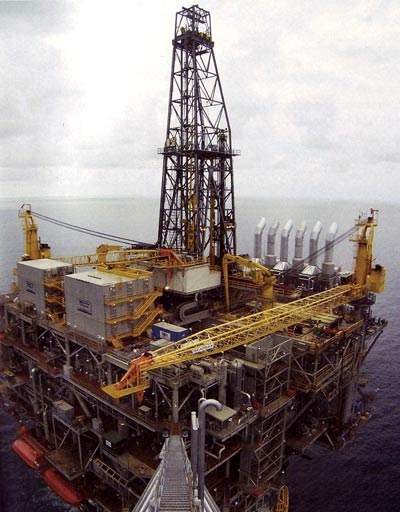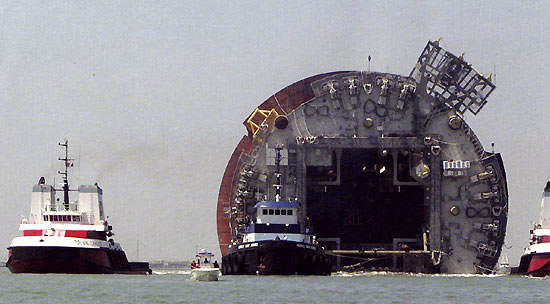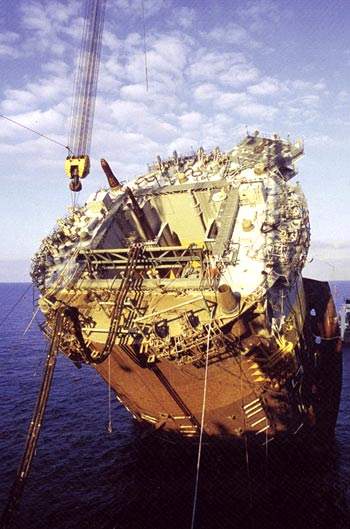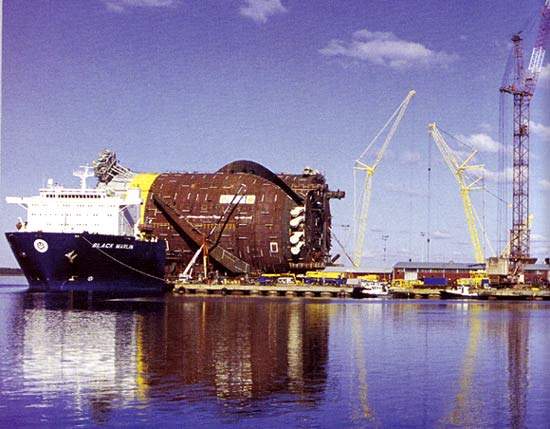The Holstein oil and gas development lies approximately 150 miles South of New Orleans in Green Canyon block 645. It was discovered in 1999 adjacent to the Mad Dog and Atlantis fields. Holstein is being developed using a Production Drilling and Quarters (PDQ) truss spar, permanently moored in 1,325m of water. Because of the size of the spar and the depth, one of the world’s largest mooring systems has been developed.
The field is operated by BP with 50% interest. Shell holds the remaining 50%. It came on stream in 2005, only 42 months after the project was sanctioned.
Following the single-well appraisal programme, the partners commissioned a comprehensive proprietary 3D seismic programme and a 4D seismic baseline survey to provide information on managing the reservoir in the future. The field has nine producing horizons – all above the salt deposits.
The field has wells in both Green Canyon blocks 645 and 644. The initial drilling plans envisage 12 producing and three water injection wells. Typical well length is 15,000ft measured depth and 13,000ft vertical depth. The wells are frac-packed wells for increased productivity.
PRODUCTION DRILLING AND QUARTERS (PDQ) TRUSS SPAR
The field development is based on a large spar. The hard tank was constructed in Finland and brought over to the US on the semisubmersible heavy lift vessel Black Marlin, while the truss, soft tank and drilling rig were built in Ingleside, Texas.
Fully assembled, the Holstein spar is 745ft (227m) long and 150ft (46m) in diameter. Its truss measures 430ft (131m) in length and weighs 6,600t. The soft tank is 25ft (8m) high and weighs 3,600t, while the hard tank is 291ft (89m) in length and weighs 25,350t. The structure provides almost 105,000t of displacement and a total maximum payload of approximately 47,000t.
TOPSIDES
Located on the spar, the PDQ topsides consist of a number of modules that have a total deadweight of 18,200t. The topsides are divided into the North and South modules and the module support frame. The North module, weighing 8,370t, contains the process equipment. The South module, which weighs 5,324t, contains the accommodation for the crew as well as three LM-2500 gas turbine generators capable of creating 54W of power. The module support frame weighs 4,421t.
DRILLING MODULE
The BP-owned drilling rig is operated by Pride International. The Holstein drilling module weighs 4,338t. The first six wells, pre-drilled by the Ocean Victory, were brought onstream in early 2005, and a further nine re-entry and drill operations will be carried out by 2006. There is space to bring up 21 wells through the middle of the spar. The four topsides modules were fabricated at the J Ray McDermott yard in Morgan City.
MOORING
After lifting the various tanks into place using up to 12 cranes, and securing them, the truss spar was upended and wet-towed to its proper location and moored. A heavy lift vessel lifted the module support frame onto the spar hull and the topsides modules were installed and welded into place.
The Holstein spar was then moored by wire and chain linked to 16 suction piles. These piles measure 18ft in diameter and 129ft in length. The sheathed spiral strand wire rope is 6in in diameter and weighs more than 2,860t while the chain is more than 6¾in and weighs a total of 4,300t.
OIL AND GAS EXPORT
The spar produces 110,000b/d of oil and 150MMft³/d of gas. The oil and gas is exported into the BP-operated Mardi Gras transportation system. The oil is fed into the Cesar oil pipeline system, which is based on a 24in trunk line to the shallow water platform at Ship Shoal block 332 in 430ft of water. The Cleopatra gas gathering system is similarly configured with a 16in line.









